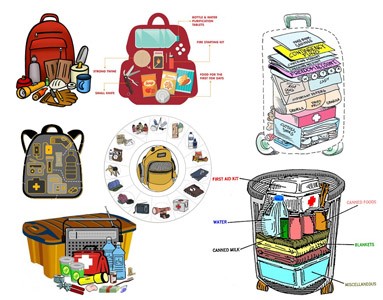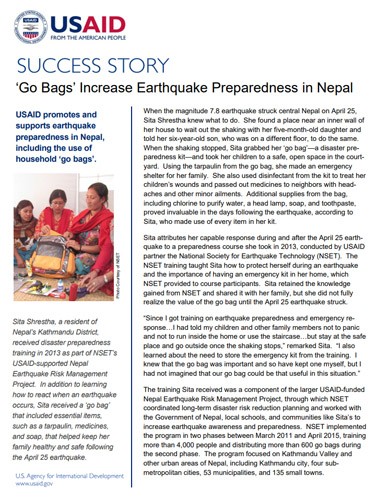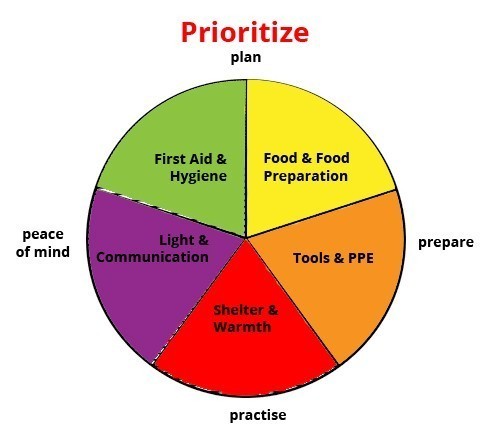The short answer is: that depends on exactly what you mean by ‘effective’ and whether or not you differentiate Go Bags / Grab bags (evacuation) and disaster/emergency preparedness kits (shelter-in-place) – hint: you’ll want both, see why. But that answer is neither satisfying nor fun so let’s get stuck in just a little deeper for it’s actually a very good question and one I love to explore.

Welcome to this ‘special edition’ blog post for the 5th anniversary of the #30days30waysUK ‘September is Preparedness Month’ campaign.
Today is day 8 and yes, you’ve guessed it – the topic is Grab Bag! 🙂
So, after this teaser visual ‘Grab Bags around the world’, let’s get right into the thick of the arguments with a quick summary of some of the most often discussed contentions:
Grab Bag – it’s a myth
Nay-sayers tend to put forward any or all of the following handful of main critiques when debating the effectiveness of grab bags (72 hours or otherwise):
- 72 hour grab bags are outdated, ‘dinosaurish’, a remnant from the cold war days, especially in resource-rich environments (such as the UK)
- no consensus, range from 72 hour to 2 weeks self-sufficiency, items disputed
- inapplicable or out of reach for the most vulnerable in society
- no scientific evidence that grab bags / disaster kits save lives
- a bad metric to measure actual personal or household preparedness
… so let’s take a closer look at these in turn.
Grab Bag – it’s a reality
The United Nations Sendai Framework for Disaster Risk Reduction 2015-2030 advocates an inclusive, all-of-society approach that recognises the importance of engagement in preparedness activities at all levels.
Household preparedness is one of the most fundamental components and a typical recommendation is for self-sufficiency during and after a disaster for at least three days. This varies, however, depending not only on where in the world you are but also your specific circumstances.
In an emergency or disaster, what usually is a ‘resource-rich’ environment may suffer quite badly quite quickly and response times of the emergency services may lag – sometimes considerably. Now what exactly ‘resource rich’ means also varies tremendously. Are we talking people as resources and/or ‘stuff’ as resources? For example, in the context of access to food, are we talking towns that have lots of shops full of produce or a rural village where food can be picked from the ground or bushes? Both may be impacted substantially in a major flood, extensive fires, earthquakes or severe storms.
Hawaii recently recognised this much more fully, recommending its population to aim for 2 weeks self-sufficiency:
I want everyone to be prepared to shelter in place. 14 days food/water/supplies. If you must go to a shelter – take supplies with you. #HurricaneLane #lane #higov #hinews
— Office of the Governor, State of Hawai`i (@GovHawaii) August 22, 2018
Just as it is, in my view, nonsensical to assign a ‘standard’ time frame for a Grab Bag, Emergency Kit, Disaster Preparedness Kit, Emergency Preparedness Kit or simply Ready Kit as the varied terminology goes, so it makes little sense to try and standardise exact contents. People have different individual needs and preferences that are highly context dependent and change over time. Rather, it would make sense to perhaps look at ‘core areas’ that kit contents should cover. Somewhat tongue in cheek I’ve written about this earlier, I suggested five grab bag items categories, namely food & food preparation (which includes water purification), tools & personal protective items, shelter and warmth, light and communication, first aid and hygiene (more on this in a minute).
So, to refute myth 1 & 2: Grab Bags are neither ‘dinausaurish’ nor confusing. Quite the contrary: there is current international recognition for household preparedness and a ‘lack of standards’ is a strength, able to accommodate local and personal needs that change over time.
Myth 3 on ‘out of reach of the most vulnerable’ in a UK context may apply to the extremely marginalised or those with special needs. Thankfully here, there are priority registers yet challenges undoubtedly remain (see ‘food for thought’ at the very end).
Preparing a grab bag / emergency supplies does incur some costs yet should be achievable even at minimal budget. Again, it is context dependent and highly personal. In the event of a sudden evacuation, UK authorities will provide basic shelter arrangements. Community resilience can be strong as recent events in Whaley Bridge show: many of the 1000+ evacuees were taken in by friends or family, found alternatives themselves while 40 people were comfortably accommodated (local news, Buxton Advertisier) Clearly a Grab Bag for a High Peak resident looks different than in other parts of the world or indeed the UK.
As to lack of scientific evidence, it is true: quality studies providing empirical evidence are super hard to come by (if you find one let me know!).
How do we prove that grab bags save lives?
Correlation is not causation, yet absence of evidence is also not evidence of absence. There is a lot of ‘anecdotal evidence’, like the blog series here on the Yorkshire Model in a community preparedness/resilience context, captured in after-action reports of emergency managers and even in a recent USAID article where a woman during the deadly Nepal earthquake used a grab bag and discusses how the items helped her family survive (see above).
Grab Bags as a bad metric to ‘measure’ preparedness? Well, it’s been done and that’s lazy science because one thing is for certain: having a Grab Bag does not simply equate preparedness in and of itself, especially if you bought a ready-made one and did not personalise it. Personal preparedness is NOT a quick tick box exercise.
However, having a Grab Bag is a good INDICATOR of personal preparedness – one amongst many others (such as always having ½ tank gas/battery in your car, knowing how to shut off your utilities, have working fire alarms etc). Interesting would be to understand what people chose to put into their Grab Bags. Very few studies tackle this but back in 2013 Northamptonshire did a survey: 7.2% of 755 respondents had a Grab Bag which contained a variety of items. If I now break their findings down into the earlier suggested categories, overall this would look like this:
Food and Food Preparation: food (non-specified), chocolate, glucose sweets, cooking equipment, matches, mini gas stove, pet food, water
Tools & personal protective items: torch, spare keys, phone charger, power leads, batteries, toolkit, paper & pencil, maps, penknife, spare mobile phone,
Shelter and warmth: blankets, thermal blankets, sleeping bag, spare clothes
Light and communication: torch, tea lights, photos, copies of insurance & other important documents, emergency plan copy, contacts list
First aid and hygiene: medication, antiseptic cream, bandages, toiletries
Depending where you are the in the world, some Grab Bag categories may be more relevant than others. For example Singapore’s guidelines for a ‘Ready Bag’ only include food and water as optional yet recommend whistles and a N95 face mask as essential items. Indeed, worldwide there exist over 70 different recommended items lists, and counting!
Knowing whether or not Grab Bags exist in a geographical area with what categories of contents begins to provide deeper insight into household preparedness capabilities and capacities, a lack suggesting potential vulnerabilities and perhaps a need for better emergency risk communication.
So, Grab Bag effectiveness – myth or reality?
I think, and the resources quoted bear me out, there is a very strong case for the effectiveness of Grab Bags, not least of all as a conversation starter to preparedness planning and action whether for 72 hours or two weeks personal preparedness or inspiring communities to resilience.
#PathfinderII team today training 15 new Flood Wardens for #Northamptonshire Here they are with their new grab bags.
We would like to thank @northantsfire for the use of Rushden Fire Station at the last minute. Great turn out and really engaged. #Volunteers #FloodAware pic.twitter.com/7thZOw5vba— Northamptonshire Prepared ⚠️ (@WNCEPTeam) June 20, 2018
Come along to west offices from 10am to 12pm, to learn more about how we prepare for emergencies with our partners #letsbereadyyork @EnvAgencyYNE @yorkrescueboat @YorkCVS @AgeUKYork @BritishRedCross pic.twitter.com/b48fnIcYc1
— York Prepared (@YorkPrepared) March 17, 2018
Which leaves me asking: do you have a Grab Bag? If so, what’s in it? If not, why don’t you have one? Follow today’s conversations and tips across social media under #30days30waysUK and explore for yourself. Don’t miss day 20 ‘September is Preparedness Month’ 2019 which will further explore ‘Shelter-in-Place’ and will reveal an exciting surprise.
Monika
Resources:
- Pickering et al 2018 The promotion of ‘Grab Bags’ as a Disaster Risk Reduction Strategy
- food for thought: Gray et al 2018 “My Grab Bag is two suitcases” via Prevention Web
- 2019 podcast Emergency Preparedness in Canada (EPIC) E29
published 8/9/2019
edited 27Jan2020 to add example: EU handing over Grab Bags to Fiji Emergency Planners
Over 50 disaster preparedness kits valued at $11,000 was handed over to the Minister for National Disaster Management in Suva today.#FBCNews #FijiNews #Fiji
More: https://t.co/g0lcGwsxLY pic.twitter.com/uGYqFBsqFi— FBC News Fiji (@FBC_News) January 27, 2020
If you like this post, please share it to help raise awareness for Emergency and Disaster Preparedness.
Tweet thank you for sharing!
For more EVAQ8 blog simply use the right hand navigation. For emergency kits and practical resources use the top navigation. For FREE resources head over to our Preparedness Hub and find out why we use humour. If you like this post, please share it to help raise awareness for Emergency and Disaster Preparedness. Thank you!
Find EVAQ8 on social media, like and follow us!






